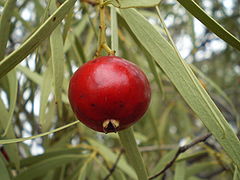Santalum acuminatum
| Santalum acuminatum subsp. var. | Quandong, Sweet quandong | |||||||||||||||||||||||||||||||||||||||||||||||||||||||
|---|---|---|---|---|---|---|---|---|---|---|---|---|---|---|---|---|---|---|---|---|---|---|---|---|---|---|---|---|---|---|---|---|---|---|---|---|---|---|---|---|---|---|---|---|---|---|---|---|---|---|---|---|---|---|---|---|

|
|
| ||||||||||||||||||||||||||||||||||||||||||||||||||||||
| ||||||||||||||||||||||||||||||||||||||||||||||||||||||||
Santalum acuminatum, the desert quandong, is a hemiparasitic plant in the Sandalwood family Santalaceae, widely dispersed throughout the central deserts and southern areas of Australia. The species, especially its fruit, is also referred to as quandong.
Santalum acuminatum grows as a tall shrub, or small tree, rarely exceeding 7 metres in height. Roots are adapted to a hemi-parasitic mechanism, utilising a haustorium, on roots able to reach out 10 metres to other root systems.
The slender to ovate leaves are pointed at the tip, are pale or yellow-green, and leathery. These are supported on a short leaf stem, 5 – 10 mm long, the leaves themselves being 45 – 115 mm long. They are tapered in outline, and arranged in opposite pairs on the branchlets.[1]
Flowers can be green or white on the outer parts, reddish or brown on the inner faces, these appear on stems, are just 2 – 3 mm across, and are fragrant.[2] Fruit is produced after four years and is red or sometimes yellow, measuring 20 and 25 mm across. A 3 mm layer of flesh covers a brain-like nut with a hard shell that encases the seed. This fruit is referred to as a drupe, it ripens from green to a shiny red in late spring or summer, and is globe shaped and 20 – 40 mm across.[3][4] The skin of the fruit is waxy.[5]
Cultivation
The plant is hemi-parasitic; able to photosynthesize, but using the root system of other plants to acquire nutrients other than sugars.[4] The Santalum genus of plants attaches to other species, in a non-destructive way, sustaining itself by their provision of nitrogen, shade, and water.[1] The roots of the species have pad-like adaptations, that nearly encircle the host's root, this is typical of this genus of sandalwoods. Hosts can be other trees, or grasses, usually several plants are utilised. The taxa recorded in this relationship are species of genera; Acacia, Maireana, and Atriplex, and many others, including hemiparasites such as Exocarpos sparteus. This mechanism allows the plant to acquire 70% of its nitrogen, and some of its water, requirements from the roots of other trees and shrubs.[6]
The tree occupies a diverse and widespread range of habitat, including creek beds, granite, gravel plains and sandy dunes. It is tolerant of drought, salt and high temperatures, and need not have a nutrient rich environ. The seedling can become established in the shade of its host, reaching for full sun once developed, so the plant is usually intermingled with host and other species.
The environs of the distribution range are subject to frequent bushfires, this requires the plant to regenerate from its roots, so the species is rarely found as an advanced tree. Those specimens exposed to bushfire and soil disturbance will occur as sprawling multi-stemmed shrubs. The plant's regrowth from the root system gives this species a lead over shrubs that recur from seed. Trees with a single main stem are in locations remote from these factors. The habit of older trees may overwhelm the adjacent plants; by monopolising the sunlight and parasitising roots of plants beyond its own canopy.
The foliage, being much paler than other trees and shrubs, makes the plant conspicuous in bushland and scrub. An occurrence of an unmolested specimen is recorded at Woodman Point in Western Australia, an area remote from the high intensity fires of altered regimes.
Host plants are needed in the establishment of an orchard, the species selected for this purpose impart factors affecting growth, resistance to infestation, and the harvest. The study of Melia azedarach (White cedar) as a host to this species revealed that the S. acuminatum acquired insecticidal compounds that increased its resistance to the Quandong Moth. Researchers then determined that neurotoxins found in the host plant, and other substances harmful to mammals, can pass into the harvested fruit.[7]
Propagation
An inadequate knowledge of the plant's ecology led to many early failures in the cultivation of this species. Commercial trials and propagation by enthusiasts have attempted to reproduce the circumstances of its native habitat; well drained soil, germination techniques, and selection of appropriate hosts have been more successful. Germinating the seed has been more successful, up to 35% when it laid aside for 12 – 18 months. Growers laying seeds into mulch, obtained from host plants, report a high rate of success.[8] Cultivation of this plant has faced other obstacles, the species is susceptible to a number of pests and fungal diseases.[9]
Pests and diseases
Soil borne agents of disease, such as Phytophthora and Pythium fungal species, may be present where the plant's preference for well drained soil is not provided. Nurseries have found the plant to be responsive to the treatments prescribed, if its presence is suspected, such as Phosphorous acid soil applications. A climate of high heat and humidity has occasionally induced black spot on the leaves.[9]
Varieties
A number of cultivars have been named in application for plant breeders' rights, two have been accepted and another has been granted. The first named cultivar of the species was named Powell’s # 1[10], but application for legal recognition of this name was withdrawn.[11] The second is known as Powell’s Red Supreme.[12] Two names are given as accepted applications in the Plant Varieties Journal: ‘Powell’s Red Supreme’ and ‘Saltbush Lane’.[13]
One variety of Santalum acuminatum is named in accordance with the International Code of Nomenclature for Cultivated Plants; following the publication of a description, Santalum acuminatum 'Frahn's Paringa Gem' (Plant Varieties Journal 17:1) became the first cultivar to be receive legal protection.[14]
Gallery
References
External links
- w:Santalum acuminatum. Some of the material on this page may be from Wikipedia, under the Creative Commons license.
- Santalum acuminatum QR Code (Size 50, 100, 200, 500)
Cite error:
<ref> tags exist, but no <references/> tag was found
